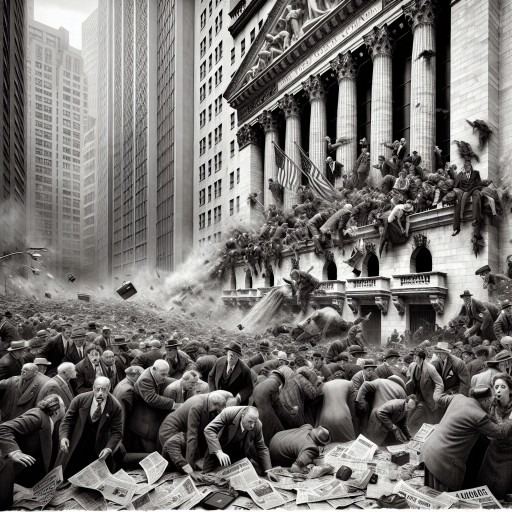
A generation which ignores history has no past and no future.
Robert Heinlein, 1907-1988, American Science Fiction Writer
Wall Street Crash of 1929: A Timeless Tale of Market Cycles and Human Behaviour
Updated Feb 12, 2024
History repeats itself as the masses never learn; they fall for the same nonsense time and time again.
Introduction:
In the chronicles of financial history, the Wall Street Crash of 1929 emerges as a poignant reminder of the precarious balance between exuberance and catastrophe. Commonly known as Black Tuesday, this event signalled the conclusion of the prosperous Roaring Twenties and heralded the onset of the Great Depression, an extensive global economic downturn.
This narrative unfolds against a thriving economy, soaring stock prices, and widespread speculation. Both substantial and modest investors were caught in the swell of optimism, engaging in margin trading and propelling prices to unsustainable heights. However, the inevitable rupture of this speculative bubble was unavoidable. On October 29, 1929, the bubble burst, sending shockwaves through the financial realm and plunging the global economy into a prolonged depression.
Nevertheless, the Wall Street Crash of 1929 is not an isolated incident. It is part of a recurring historical pattern observed across financial landscapes. From the Tulip Mania of the 17th century to the South Sea Bubble of the 18th century, and from the Dotcom Bubble of the late 20th century to the 2008 Financial Crisis and the recent COVID-19 market upheaval, recurring themes of greed, speculation, and risk neglect become evident.
Each of these crashes followed a period of economic prosperity and market optimism, where caution was abandoned and speculation ran rampant. Each culminated in a market crash, witnessing the bubble’s collapse and subsequent panic selling. Yet, in the aftermath of each collision, a distinctive buying opportunity materialized. Understanding the intrinsic value of assets, contrarian investors seized the moment, purchasing when prices were low and reaping the rewards as the market eventually recovered.
The tale of the Wall Street Crash of 1929, and indeed all market crashes, serves as a cautionary reminder. It underscores the perils of unchecked speculation and emphasizes the significance of comprehending the true value of assets. Simultaneously, it illuminates the opportunities that can arise during crises for those bold enough to swim against the tide. As we navigate the currents of today’s financial markets, these lessons from the past stand as valuable guides, aiding in avoiding speculative pitfalls and recognizing the opportunities that crises may present.
Events Leading to the Crash of 1929: A Prelude to Financial Turmoil
For an extended period, investors had been leveraging borrowed funds to engage in stock purchases, a practice that gained momentum in the late 1920s as credit availability surged and the stock market experienced unprecedented growth. The act of borrowing to acquire stocks, essentially representing ownership shares in corporations, involved committing a “margin,” which served as a down payment on the stock purchase, often as low as 10% of the total acquisition cost. Investors were only obligated to pay additional amounts if the stock price declined, with the loan offset by the appreciating value of the stock.
In 1927, brokers borrowed a staggering $4 billion, marking a 33% increase from the preceding year, intending to lend these funds to stock buyers subsequently. By the close of 1928, brokers’ loans had skyrocketed to $6.4 billion, reflecting an astounding 56% surge within a single year. This rapid escalation in borrowed funds laid the groundwork for the events leading up to the eventual Crash of 1929.
Wall Street Crash of 1929: Pivotal Shift Fueled by Easy Money
In 1929, a significant turning point unfolded as nearly $4 out of every $10 lent by banks was directed towards stock purchases. Notably, even major corporations, including John D. Rockefeller’s Standard Oil of New Jersey, Chrysler, and General Motors, engaged in the lending business, reaping millions of dollars in stock loans.
Remarkably, the era saw a surge in banks reporting record profits, primarily attributed to market trading rather than traditional lending practices. This shift resembled the conditions leading up to the 1929 crash, where a substantial portion of banks’ lending entered the stock market, setting the stage for potential trouble.
As stock values continued to plummet, declining by 12.8% on the subsequent Monday, October 28, and nearly another 12% on Black Tuesday, October 29, one of the darkest days in stock market history, the six-day span witnessed the evaporation of almost one-third of the market’s value—amounting to a staggering $25 billion in lost savings.
The repercussions of the stock market crash were severe, wiping out life savings for countless individuals and plunging many into substantial debt. Witnessing the aftermath of this borrowing frenzy, federal officials were resolute in preventing a recurrence. They implemented measures to maintain high-interest rates and discourage excessive borrowing, reducing consumer and corporate borrowing. Consequently, consumers struggled to afford homes; companies lacked funds for expansion, and job losses ensued as businesses contracted. This economic downturn indicated a broader slump, eventually culminating in the devastating Great Depression.
The stock market crash of 1929 served as a harbinger of economic hardship. Still, the subsequent policy responses aimed at averting a repetition inadvertently propelled the nation into the profound slump of the Great Depression. This perspective is derived from the insights shared in “Six Days in October: The Stock Market Crash of 1929” by Karen Blumenthal, published in 2002.
Wall Street Crash of 1929: A Glimpse into Key Events
The narratives below, sourced from the 1930 Blogspot, offer insights into notable moments from the aftermath of the Wall Street Crash of 1929, as the Wall Street Journal reported.
June 2 to 7, 1930 – Wall Street Journal:
– Henry Ford expresses optimism, stating that business is returning to normal and the worst of the economic depression is over.
– Brokers and financiers anticipate an improvement in the business depression, believing that the next turn will be for the better.
– The ongoing dull period on Wall Street allows brokers to hone their skills in various games, including golf, bridge, checkers, chess, and ping pong.
June 13, 1930 – Wall Street Journal:
– Business fails to improve as predicted, leading to decreased market sentiment.
– While business volume remains relatively steady, lower prices impact earnings, with wages not declining as quickly as earnings.
– The market perplexes observers by declining, contrary to the expectations of a rally held by a majority of Wall Street.
June 23, 1930 – Wall Street Journal:
– Col. Ayres, VP of Cleveland Trust, forecasts an uneven recovery in stock and commodity prices by Labor Day, attributing it to current consumption exceeding production.
– Differentiates between two types of depression, namely “V”-shaped and “U”-shaped.
– Reducing the rediscount rate to 2 1/2 per cent is seen as beneficial, indicating prolonged easy credit and potentially benefiting various industries, including farming, building, and construction.
– Stocks continue to decline, with notable drops in large trading stocks. Some rally on short covering toward the close after hitting new yearly lows.
August 6, 1930:
– The market is viewed as having set conditions for a positive uptrend based on both fundamental and technical grounds.
– One year has passed since the start of the downturn, aligning with the typical historical duration of depressions.
– Favorable seasonal factors are noted, and recent range-bound trading is seen as the market building up its technical strength.
Are not many experts already making such comments now?
The market seemed to gain strength after two days of consolidation. Bulls found encouragement in the failure of bear efforts to prompt liquidation, coupled with an $8 million increase in brokers’ loans, considered a sign of greater public participation. Retailers showed strength following news of improving August sales at Woolworths. Major industrials rebounded vigorously from recent lows, and amusements, utilities, and banks also displayed strength. The market witnessed increased volume as prices rose, with “bullish demonstrations” spreading. Rails and oils were neglected, but the market closed at the day’s highs. The bond market was robust, with the Dow 40 bond average reaching a new 1930 high of 97.29; high-grade corporates were firm, convertibles were more active, and government securities were irregular with little change.
Market opinions were sharply divided; bears cited repeated failures to break through the 241 resistance level, unfavourable farm news, and recent adverse business developments. On the other hand, bulls pointed to market resistance to selling, with volume drying up on declines and the strong positive reaction to good news indicating the path of least resistance was upward.
August 16, 1930:
Stocks staged a sensational late rally attributed to a “wild covering movement” by overextended shorts. Pessimism over drought’s effects on business had induced “perhaps the largest” short interest in history. Bears made some further attempts early, particularly against coppers. News of heavy rains in drought areas caused a short-covering movement, at first cautious but turning into a rout in the late afternoon. There were “spectacular uprushes” in stocks under recent pressure, including US Steel, J.I. Case, and Vanadium, and the general market rose aggressively. The bond market was dull, with corporates and preferreds up, foreign governments mixed, and US government securities steady.
August 25, 1930:
Alarmed by a shrinking population, France budgeted $45 million to encourage large families, with parents to receive $20 for a second child and $30 for each additional one.
Bulls found encouragement in President Hoover’s statement that a tax cut might be continued, favourable business reviews, and market action on Friday. Some unsettlement in the oil group was caused by a decline in gasoline prices and high inventories despite a recent reduction. However, the weakness was moderate and didn’t spread to other sectors. Major industrials and trading favourites showed strength, reaching their best levels since the July peak. Tobacco, banks and trusts, and utilities were strong. The bond market in the Saturday session was quiet but continued higher, with most activity in a few rails and industrials, and the Dow 40-bond average reached a new 1930 high of 96.87.
Editorial:
Some suggested banning short-selling as an aid to business recovery, but recent market swings were attributed not to short-selling but to public recognition of reduced earning power. Similarly, farmland in the Corn Belt had declined by 2/3 from wartime levels, though no one had been selling it short. The recent blame on naked short selling for the damage caused to bank stocks led to its elimination. Time will tell if this ban on naked short selling was a factor or delayed the inevitable. Weak banks are likely to fail and should be allowed to be taken over or sink without extended lifelines, preventing more damage.
Sept 11
The market is considered more vital technically from a recent period of consolidation, moving upward on higher volume; declines of June and early August are seen as having shaken out weak hands, as indicated by shrinkage in brokers’ loans. Recent economic news, including steel production, retail, and mail-order sales, has also been encouraging. Roger Babson’s switch to a bullish stance has also attracted attention. All indications point to good-sized gains in stocks shortly, though third-quarter earnings reports in a few weeks may change the trend.
An out-of-work broker asked a friend who owned a circus for work. His friend said the circus gorilla had recently died, and if the broker wanted to get into the gorilla’s skin, swing around, growl, and amuse the children, he could have the job. Things went well until one day, the rope the “gorilla” was swinging on snapped and catapulted him into the lion’s cage. The lion let out a roar, which the “gorilla” answered with a timid Yelp. The lion roared louder, and the “gorilla” lost his nerve and started screaming for help. The lion came closer and whispered, “Shut up, you damned fool; you’re not the only broker out of a job.”
Sept 13
The current consensus is that “there will be a good advance shortly followed by a setback before the end of the year” when disappointing Q3 reports appear. However, when “predictions … are so nearly unanimous,” market action may contradict the general opinion.
The parallels between events 80 years ago and the current scenario are striking. When people become accustomed to easy money, they seek more; only significant pain can deter them. The dot-com meltdown in 2000 briefly halted investors, but they plunged into real estate shortly after, inflating another bubble. Presently, a renewed focus on stocks showcases a recurrent pattern of speculative behaviour.
Rethinking Banking: A Modern Twist
Banks traditionally thrive on loans, but today’s major banks are embracing greater risks, with the stock market contributing up to 50% of their revenues. Government funds are being used to magnify these risks.
Reflecting on the past, Mr Durant, once among Wall Street’s wealthiest, controlled over 4 billion dollars before the 1929 crash, reducing to a mere $250 afterwards.
Differences exist between the current scenario and the past. In 1929, the Fed cut back on lending and increased interest rates. Presently, aggressive rate reductions and massive liquidity injections characterize our approach. However, the U.S. is now a debtor nation requiring daily infusions, and global investors may reconsider lending at such low rates.
Challenges loom with combined private and government debt exceeding 400% of GDP. The Fed may be compelled to raise rates, relinquishing control to foreign investors.
Despite claims of a different landscape, inflation remains a lurking problem. In 1929, immediate effects resulted from aggressive rate hikes; this time, a delayed impact is expected due to lowered rates and substantial market injections, possibly leading to runaway inflation and potential hyperinflation.
While asserting our strong manufacturing past, today’s reality sees an overreliance on paper production, with debt constituting over 70% of GDP. Sustainable economic success hinges on individuals embracing perpetual debt, but with banks reducing lending and plummeting home values, the only viable choice for consumers is to cut down debt or face dire consequences.
The Impact of U.S. Consumer Trends on Global Economies
Historically, the average American consumer has little to no savings and has recently begun saving out of necessity. Last month, consumer credit plummeted by almost 22 billion, equivalent to a 10% annual decline, with the expectation that these numbers will continue to rise. As consumers reduce debt and increase savings, How can an economy built on debt recovery thrive?
The change in spending patterns among American consumers is anticipated to have a widespread impact, affecting every nation. No other country matches America’s purchasing power, and there’s no immediate substitute. While Asia may eventually emerge as a replacement, this transition will take 3-6 years.
Insights from the Wall Street Crash of 1929 Analysis
Analyzing patterns suggests that the Dow is overdue for a correction, with projected ranges between 8100-8300 and a potential dip to 7700 if downward momentum intensifies.
The subsequent phase could see a rally, possibly reaching current highs or even surpassing them. Signs hint at a potential higher rally, but confirmation awaits, requiring the Dow to hit 10,000 for indicators to issue a new buy or sell signal.
Despite the strength of the anticipated rally, expectations lean towards an eventual failure, leading to a potentially sharp and impactful correction.
Not to know what has been transacted in former times is to be always a child. If no use is made of the labors of past ages, the world must always remain in the infancy of knowledge. Marcus T. Cicero, c. 106-43 BC, Great Roman Orator, Politician
Other Articles of Interest

Clear Proof Millennials Are Dumbest Generation

Third Wave Feminism Criticism: Valid Points Amidst the Debate

Investor Sentiment in the Stock Market: Maximizing Its Use

Mastering the Art of Retirement: How to Start Saving for Retirement at 45 with Grace and Style

Third Wave Feminism is Toxic: Its Impact on America

What is the Average Student Loan Debt in the US? Understanding the Crisis

Student Debt Crisis Solutions: Halting the Madness is Essential

Financial Freedom Reverse Mortgage: A Sophisticated Strategy for a Comfortable Retirement

Early Retirement Extreme: A Philosophical and Practical Guide to Financial Independence

Student Loan Refinance: A Smart Move Towards Financial Freedom – Poise in Debt Reduction

How to Lose Money: The Dangers of Ignoring Market Trends and Psychology in Stock Investing

How much has the stock market gone up in 2023? -A Refined Analysis

Maximizing Gains: Mastering Market Sentiment Indicators

How to Achieve Financial Goals: The Midas Touch for Your Financial Dreams

Sophisticated Strategies for US Dollar Index Investing: Elevate Your Forex Game
Comic Strip Illustrating Mass Mindset
Mass Psychology or Contrarian Investing
Stock Market Corrections-Nothing but Buying Opportunities
Markets; time to dance or Drop
Contrarian Investment Guidelines
Seven rules for contrarian investing
Wall Street Crash of 1929 and why Crashes are buying opportunities


